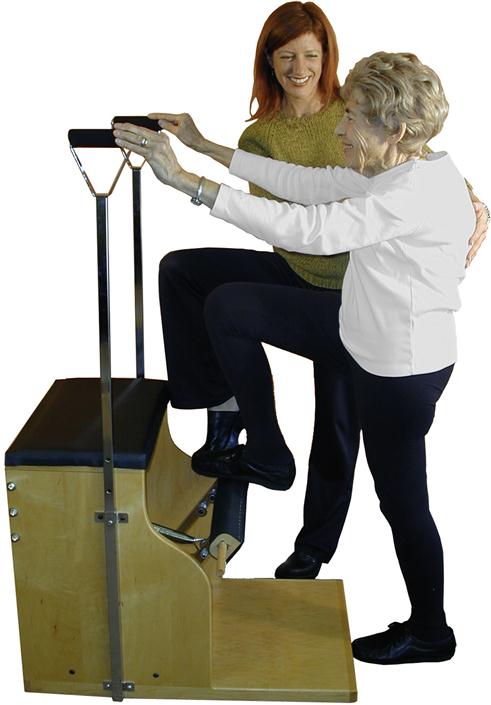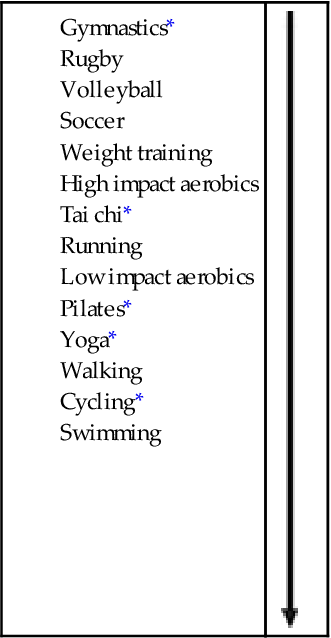Safe Pilates for bone health
Sherri R. Betz
Introduction
Baby boomers are flocking to Pilates and yoga classes! They appear to be seeking a more gentle form of exercise that focuses on posture, balance, flexibility and relaxation. It is those in the 30–60-year-old age range who mostly comprise the population seeking Pilates classes (von Sperling de Souza & Brum Vieira, 2006). Imagine a deconditioned 60-year-old woman with decreased bone density, mild thoracic kyphosis and slightly decreased balance attending a Pilates class for the first time. What exercises would she be expected to do? Does the instructor have any information as it pertains to dealing with osteoporosis or teaching exercise safely to an older adult? These are all very important questions for the baby boomer to ask if they are to participate safely in this style of exercise.
Pilates background
If you take a look at Joseph Pilates’ original method of exercise as outlined in Return to Life you would see that the first three exercises are: Hundred, Rollup and Rollover. All three are contraindicated for someone with osteoporosis (Sinaki, 2013). At first glance, the knowledgeable practitioner would advise their patient or client to completely avoid the Pilates exercise method. However, the guiding principles of Joseph Pilates’ original work focused on breathing, whole body health and whole body commitment. The vast majority of Pilates’ work was developed in the early 1900s (Pilates & Miller, 2003). He and his wife, Clara, developed the Contrology exercise method, and in 1934 Joseph wrote a small book exposing his controversial theories about health and fitness, called Your Health (Pilates, 1934). Return to Life followed soon after as a low-cost, home exercise program of 34 mat exercises originally called ‘Contrology’. Many practitioners believe that Pilates mat classes or programs should always follow this strict regimen or sequence of exercises, as set forth in Return to Life.
Pilates interpretations
Without important modifications, many clients coping with pathological conditions would be unable to participate safely in Pilates exercise programs. If the Pilates method is seen as a philosophy or a system of precise movements coupled with specific breathing patterns, the method can be easily modified for any type of client. The essential movement elements of Pilates are breathing, alignment and control. There are several styles and interpretations of Pilates, some being very true to the original exercises, some that do not believe in modifications and others that use Pilates as a form of rehabilitation. The Pilates Method Alliance (PMA), the non-profit professional association for Pilates teachers, archives these lists of exercises but the PMA believes that Pilates should evolve along with the advances in scientific research. Bone health experts believe it is imperative that traditional Pilates be modified for the older adult and especially for the osteoporotic client. For this reason, this chapter will focus on Polestar Pilates, a rehabilitation-based Pilates approach as compared to the historical or traditional Pilates method (Anderson & Spector, 2000).
Why Pilates for older adults and bone health?
At least 60% (20/34) of Pilates mat exercises involve spine flexion. Joseph’s idea about spinal health stemmed from his theory that the spine should be flat ‘like a newborn baby’ (Pilates & Miller, 2003). We know that older adults tend toward thoracic kyphosis even without the presence of osteoporosis. Kyphosis increases with age, with the most rapid increases occurring between ages 50 and 60 years (Ball et al., 2009).
If Pilates is seen as a system of balanced muscle development, then the Pilates teacher should consider selecting the specific Pilates exercises that would bring the client’s body back into balance. For instance, in a client with a forward head and increased thoracic kyphosis, we would select Pilates exercises that involve thoracic extension and avoid exercises that involve thoracic flexion. Our fitness culture is extremely attracted to abdominal exercises with a flexed spine position in an effort to flatten the abdominals. Ironically, the best way to facilitate core control is with exercises or postures performed in a neutral spine (Rydeard et al., 2006).
One of the important movement principles in Polestar Pilates is axial elongation. Joseph Pilates never used this term in his original work but it is analogous to a concept he described called ‘centering’. Axial elongation is the idea of lengthening the spine and the extremities away from center from head to coccyx, from shoulder girdle to hand/fingers and from pelvic girdle to feet/toes. This action appears to facilitate core control, activating the small or local joint stabilizers throughout each joint system (Smith & Smith, 2005). Levin adapted this concept for the musculoskeletal system which is a good model for describing musculoskeletal control (Hutson & Ellis, 2006).
The concept of loading and unloading is important in postural training and bone health. Bones and joints need both compression and decompression to stimulate bone formation and synovial fluid to keep tissues healthy. Constant compression has a detrimental effect on bone and joint tissues, as does non-weight-bearing (Jortikka et al., 1997). Unloading may create a tensile force in the vertebral bodies that is beneficial for bone. Unloading may also decrease shear and compression between vertebral segments. Core control occurs with the concept of axial elongation so that deep stabilizers of the spine are triggered with the idea of lifting the ribcage off the pelvis and the head away from the torso.
Pilates as compared to other forms of exercise
Pilates is an ideal transition from water-based to land-based exercise. Older adults often love aquatic classes, but they may not be the best choice for the older adult with osteoporosis. Bravo et al. (1997) studied 70 postmenopausal women with low BMD, ages 50–70 years, exercising in waist-high water for 60 minutes, including 40 minutes of jumping and muscular exercises designed to promote bone accretion, strength and endurance. Bravo saw a significant decrease in spine BMD and no change in the femoral neck after 12 months of vigorous water exercises three times weekly. Also, cyclists appear to have lower bone mineral density as compared to runners and age-matched controls even with higher calcium intake in several studies of healthy males. If Pilates were placed in a bone-building exercise spectrum graded from most to least effective, it might look as shown in Box 72.1.
Balance
Traditional Pilates mat classes generally do not contain standing balance activities and there are no original Pilates mat exercises that incorporate single leg stance. There are only three traditional apparatus exercises (see Fig. 72.1) that involve single leg balance: Forward and Sideward Lunge on the Chair and the dismount for Control Balance on the Reformer. However, many Pilates apparatus exercises are taught in upright stance with emphasis on lower extremity and torso organization. Dynamic weight-shifting activities with a special focus in sidestepping should be added to a Pilates program for the geriatric client. Training should include arm reaching and neuromuscular patterning to facilitate proper protective postural responses. Since falls are the leading cause of injury-related death and hospitalization in people age 75 years and older (Lord et al., 2003), balance activities should be included in Pilates classes.

Pilates improves balance
Roller et al. (2012) conducted a randomized controlled trial with 72 subjects ranging in age from 65 to 95 years who were known fallers or at risk for falls. Subjects participated once weekly for 45 minutes in a Pilates Reformer Class lasting 10 weeks. Outcome measures showed significant improvements on the Activities-specific Balance Confidence (ABC) scores, the Timed Up and Go (TUG), the Berg Balance Scale, the 10-Meter Walk Test and the Adaptation Test (ADT) on the Smart Balance Master™ (NeuroCom International, Clackamas, OR). AROM significantly increased for straight leg raise, hip extension and ankle dorsiflexion. Sensory Organization Test™ (SOT; NeuroCom International) composite equilibrium scores increased significantly in both exercise and control groups by 6.5/100 points suggesting improved postural stability or learning effect. The control group demonstrated significant change on the SOT only.
Polestar Pilates
Polestar Pilates advocates working in bare feet to exercise the intrinsic muscles of the foot, decrease dependence on shoes and promote increased awareness of the feet.
Generally, the balance progression in Polestar Pilates is to work sequentially from:
< div class='tao-gold-member'>
Stay updated, free articles. Join our Telegram channel

Full access? Get Clinical Tree









